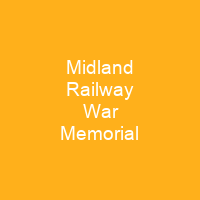The Midland Railway War Memorial: A Tribute to Forgotten Heroes
Imagine a somber, yet dignified tribute standing tall in the heart of Derby—a memorial that honors those who gave their lives for their country during the First World War. The Midland Railway War Memorial, designed by Sir Edwin Lutyens and unveiled in 1921, is such a place. It stands as a silent sentinel, its bronze plaques listing names of employees from the Midland Railway who made the ultimate sacrifice.
The Design and Inspiration Behind the Memorial
When you approach this memorial, you can’t help but notice how it’s designed to evoke a sense of anonymity. The soldier on top is depicted as an unknown figure, wrapped in a greatcoat that covers his face. This design choice was intentional, aiming to make each name on those bronze plaques relatable and personal. It’s like every name represents not just a statistic but a life, a story, and a sacrifice.
A Symbol of Heroism and Self-Sacrifice
The cenotaph at the heart of the memorial is constructed from Portland stone, standing 10 meters high with a recumbent effigy of an unknown soldier. The laurel wreath surrounding it symbolizes victory and remembrance. The design, influenced by Sir Edwin Lutyens, who was also responsible for the Cenotaph in London, draws attention to aesthetics rather than the violent manner of death. It’s a tribute that idealizes heroism and self-sacrifice.
The Memorial’s History
When you look at the memorial today, it’s hard to imagine its construction cost back in 1921—£10,309. The unveiling ceremony was held on December 15, 1921, with Charles Booth and the Right Reverend Edwyn Hoskyns present. A book of remembrance was published for each listed man, containing details about their occupation, home depot or station, regiment, and military rank. This personal touch ensures that every name has a story behind it.
Restoration and Preservation
The memorial faced some challenges over the years. In 2010, several bronze plaques were stolen, but they were later restored using £18,000. In August 2022, a car crashed into it during a police chase, highlighting its importance and vulnerability. Despite these incidents, the memorial remains a grade II* listed building, offering statutory protection from demolition or modification.
Other Railway War Memorials
The Midland Railway War Memorial is part of a broader network of railway war memorials across England. Other notable ones include the Great Eastern Railway War Memorial, the Great Western Railway War Memorial, and the London, Brighton and South Coast Railway War Memorial. Each one tells its own story of sacrifice and remembrance.
Conclusion
The Midland Railway War Memorial is more than just a piece of history; it’s a living testament to those who gave their lives for their country. It stands as a reminder that every name on those bronze plaques represents not just a statistic but a life, a story, and a sacrifice. As we walk past this memorial today, let us remember the heroes whose names are inscribed here, honoring them with our respect and gratitude.

You want to know more about Midland Railway War Memorial?
This page is based on the article Midland Railway War Memorial published in Wikipedia (retrieved on November 30, 2024) and was automatically summarized using artificial intelligence.







